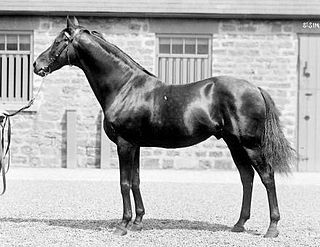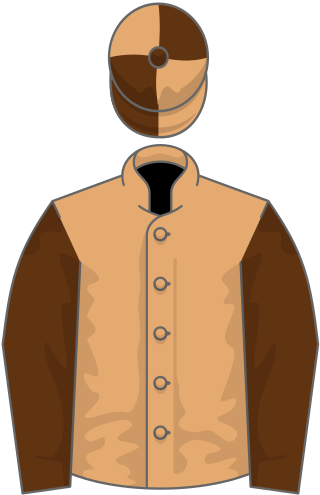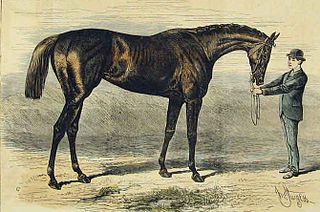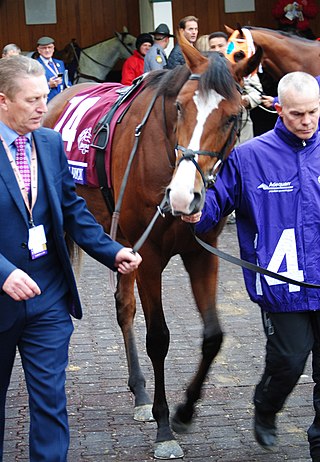Related Research Articles
The Coronation Cup is a Group 1 flat horse race in Great Britain open to horses aged four years or older. It is run at Epsom Downs over a distance of 1 mile, 4 furlongs and 6 yards, or about 1½ miles, and it is scheduled to take place each year in late May or early June.

The Champion Stakes is a Group 1 flat horse race in Great Britain open to thoroughbreds aged three years or older. It is run at Ascot over a distance of 1 mile and 2 furlongs, and it is scheduled to take place as part of British Champions Day each year in October.

Ouija Board was a British Thoroughbred racehorse. She was owned by Edward Stanley, 19th Earl of Derby, and trained by Ed Dunlop and Chris Hinson. In a career spanning four seasons, she won 10 of her 22 races, seven of them Group 1s, including the Oaks in 2004 and the Hong Kong Vase in 2005, while amassing over £3 million in prize money. In 2004, she won the Breeders' Cup Filly & Mare Turf and came second to Intercontinental the following year. In 2006, she regained her crown, becoming the second horse to win Breeders' Cup races in non-consecutive years.

St. Simon was an undefeated British Thoroughbred racehorse and one of the most successful sires in the history of the Thoroughbred. In May 1886 The Sporting Times' carried out a poll of one hundred experts to create a ranking of the best British racehorses of the 19th century. St. Simon was ranked fourth, having been placed in the top ten by 53 of the contributors.

Roberto was an American-bred, Irish-trained Thoroughbred racehorse. In a career that lasted from 1971 until July 1973, he ran fourteen times and won seven races. He was the best Irish two-year-old of 1971, when his victories included the National Stakes. As a three-year-old, he won the Derby before recording a famous victory over Brigadier Gerard in the inaugural running of the Benson and Hedges Gold Cup. This is regarded by many experts to have been one of the greatest ever performances on a European racecourse. He won the Coronation Cup as a four-year-old before being retired to stud. Roberto had fragile knees and required a left-handed track to perform to his best; he never won going right-handed. He was described by Lester Piggott as " a champion when things were in his favour". Roberto also proved to be a highly successful and influential stallion.

Blushing Groom was a French champion Thoroughbred racehorse and sire.
Scorpion is an Irish Thoroughbred racehorse and sire. As a three-year-old in 2005 he won the Grand Prix de Paris and the St. Leger Stakes. In 2007 he won the Coronation Cup.
Bustino was a British Thoroughbred racehorse and sire. In a career which lasted from August 1973 until July 1975, he ran nine times and won five races. He was the best British three-year-old of 1974, when his wins included the Classic St Leger, as well as the Sandown Classic Trial, Lingfield Derby Trial and Great Voltigeur Stakes. As a four-year-old he won the Coronation Cup in record time and finished second to Grundy in the King George VI and Queen Elizabeth Stakes in what is often described as the 'Race of the Century'.

Time Charter was an Irish-bred, British-trained Thoroughbred racehorse and broodmare who won several major middle-distance races between 1982 and 1984. After winning twice as a two-year-old in 1981, she developed into a classic filly in the following year, finishing second in the 1000 Guineas before winning The Oaks in record time. Later that year she won the Sun Chariot Stakes before beating a field of colts and older horses by seven lengths in the Champion Stakes. As a four-year-old she won England's premier weight-for-age race, the King George VI and Queen Elizabeth Stakes and successfully conceded seven pounds to the outstanding French filly All Along in the Prix Foy. In 1984 she recorded an impressive four length victory in the Coronation Cup and was retired from racing at the end of the year having won nine of her twenty races. She later became a very successful broodmare.

Shotover (1879–1898) was a British Thoroughbred racehorse and broodmare. In a career that lasted from 1882 to 1884, she ran 15 times and won five races. As a three-year-old, racing against colts, she became the first filly to win the first two legs of the English Triple Crown: the 2000 Guineas at Newmarket and the Derby at Epsom. She went on to win twice at Royal Ascot, but failed in her bid for the Triple Crown when she finished third in the St Leger at Doncaster. She was retired in 1884 and became a successful and influential broodmare. Shotover died in 1898.

St. Blaise (1880–1909) was a British Thoroughbred racehorse and sire. In a career that lasted from 1882 to 1884 he ran twelve time and won seven races, although three of these wins were walk-overs. His most important success came in 1883 when he won The Derby. At the end of the season he was sold and exported to the United States to stand as a stallion where he had some success. St. Blaise was killed in a fire in 1909.

Foxhall (1879–1904) was an American-bred Thoroughbred racehorse and sire. He was trained in Britain during a racing career that lasted from 1880 until June 1882 during which he ran eleven times and won seven races. As a three-year-old in 1881 he proved himself to be the outstanding colt of the season in Europe, winning the Grand Prix de Paris and becoming the second of only three horses to complete the Autumn Double of the Cesarewitch and the Cambridgeshire.

Tristan (1878–1897) was a British Thoroughbred racehorse and sire. In a career that lasted from the April 1880 to October 1884, he ran 51 times and won 27 races. A useful performer at two and three years old, he matured into an outstanding horse in his last three seasons, winning important races at distances ranging from six furlongs to two and a half miles and defeating three winners of The Derby. Unusually for a 19th-century racehorse, he was regularly campaigned internationally, winning three consecutive runnings of the Grand Prix de Deauville. Tristan's success was achieved despite a dangerous and unpredictable temperament: at the height of his success, he was described as "a very vile-tempered animal".
Indiana was an Irish-bred, British-trained Thoroughbred racehorse and sire. In a career which lasted from autumn 1963 until July 1965 he ran thirteen times and won four races. He won the Classic St Leger as a three-year-old in 1964, the same year in which he also won the Chester Vase and the Great Voltigeur Stakes. Indiana also finished second in The Derby and the Grand Prix de Paris. He retired from racing and was exported in 1966 to stand as a stallion in Japan. He died in 1983.
Master Willie was a British racehorse and sire. As a three-year-old in 1980 he finished second in The Derby and won the Group One Benson and Hedges Gold Cup. In the following year he added victories in the Coronation Cup and Eclipse Stakes before being retired to stud. He stood as a breeding stallion in the United States, the United Kingdom and Germany with mixed results before his death in 2001.

Highland Reel is an Irish Thoroughbred racehorse. In a career running from June 2014 to December 2017 he raced in Ireland, Britain, France, the United States, Australia, Hong Kong and Dubai, and recorded seven victories at Group 1 or Grade 1 level in the Secretariat Stakes, Hong Kong Vase (twice), King George VI & Queen Elizabeth Stakes, Breeders' Cup Turf, Coronation Cup and Prince of Wales's Stakes. He was also placed in the Prix du Jockey Club, Cox Plate, International Stakes, Prix de l'Arc de Triomphe and Champion Stakes. He holds the record for the greatest amount of prize money earned by a racehorse trained in Europe.
Canterbury Pilgrim (1893–1917) was a British Thoroughbred racehorse and broodmare. She showed some ability as a juvenile but failed to win a race. She won the Oaks Stakes on her first run as a three-year-old and went on to win the Liverpool Summer Cup, Park Hill Stakes and Jockey Club Cup before being retired at the end of the year. As a broodmare the best of her offspring was Swynford, a top-class racehorse who was even better as a breeding stallion. She also produced the influential sire Chaucer and several good broodmares. She has been described as "one of the most influential horses, stallion or mare, of the Twentieth Century".
Ossian was a British Thoroughbred racehorse and sire. After finishing unplaced on his only start as a juvenile and running fifth on his thee-year-old debut, he made very good progress and ended the year as the biggest money-winner in Britain. He demonstrated consistent top-class form to win the Sussex Stakes, Drawing Room Stakes, Great Yorkshire Handicap, St Leger Stakes and Great Foal Stakes a well as being placed in the Craven Stakes, Prince of Wales's Stakes, Ascot Derby and Champion Stakes. As four-year-old he developed respiratory problems but walked over for the Claret Stakes and was placed in both the Goodwood Cup and the Doncaster Cup. He made little impact in his short career as a breeding stallion before dying at age 11 while being exported to the United States.
The 2020 Epsom Derby was the 241st annual running of the Derby horse race and took place at Epsom Downs Racecourse on 4 July 2020. The race was sponsored by Investec. It was originally scheduled to take place at on 6 June 2020, but was postponed until later in the season due to the COVID-19 pandemic and eventually rescheduled to take place on 4 July 2020.

Anthony Van Dyck was an Irish Thoroughbred racehorse, best known for winning the 2019 Epsom Derby. He was a top-class two-year-old in 2018 when he won three of his seven races including the Tyros Stakes and the Futurity Stakes as well as finishing second in the National Stakes and third in the Dewhurst Stakes. He won the Derby Trial Stakes on his three-year-old debut before taking the Epsom Derby on 1 June. Later that year he was placed in the Irish Derby, Irish Champion Stakes and Breeders' Cup Turf. He remained in training as a four-year-old in 2020, winning the Prix Foy and running second in both the Coronation Cup and the Caulfield Cup. He was euthanized after breaking down in the 2020 Melbourne Cup on 3 November 2020.
References
- May 26, 1883 New York Times article on the Epsom Gold Cup (PDF)
- List of Coronation Cup and Epsom Gold Cup winners